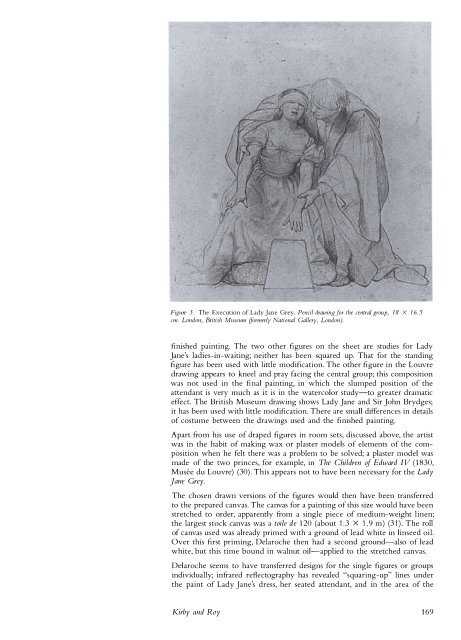Historical Painting Techniques, Materials, and Studio Practice
Create successful ePaper yourself
Turn your PDF publications into a flip-book with our unique Google optimized e-Paper software.
Figure 3. The Execution of Lady Jane Grey. Pencil drawing for the central group, 18 X 16.5<br />
cm. London, British Museum {fo rmerly National Gallery, London}.<br />
finished painting. The two other figures on the sheet are studies for Lady<br />
Jane's ladies-in-waiting; neither has been squared up. That for the st<strong>and</strong>ing<br />
figure has been used with little modification. The other figure in the Louvre<br />
drawing appears to kneel <strong>and</strong> pray facing the central group; this composition<br />
was not used in the final painting, in which the slumped position of the<br />
attendant is very much as it is in the watercolor study-to greater dramatic<br />
effect. The British Museum drawing shows Lady Jane <strong>and</strong> Sir John Brydges;<br />
it has been used with little modification. There are small differences in details<br />
of costume between the drawings used <strong>and</strong> the finished painting.<br />
Apart from his use of draped figures in room sets, discussed above, the artist<br />
was in the habit of making wax or plaster models of elements of the composition<br />
when he felt there was a problem to be solved; a plaster model was<br />
made of the two princes, for example, in The Children if Edward IV (1830,<br />
Musee du Louvre) (30). This appears not to have been necessary for the Lady<br />
Jane Grey.<br />
The chosen drawn versions of the figures would then have been transferred<br />
to the prepared canvas. The canvas for a painting of this size would have been<br />
stretched to order, apparently from a single piece of medium-weight linen;<br />
the largest stock canvas was a toile de 120 (about 1.3 X 1.9 m) (31). The roll<br />
of canvas used was already primed with a ground of lead white in linseed oil.<br />
Over this first priming, Delaroche then had a second ground-also of lead<br />
white, but this time bound in walnut oil-applied to the stretched canvas.<br />
Delaroche seems to have transferred designs for the single figures or groups<br />
individually; infrared reflectography has revealed "squaring-up" lines under<br />
the paint of Lady Jane's dress, her seated attendant, <strong>and</strong> in the area of the<br />
Kirby <strong>and</strong> Roy 169


